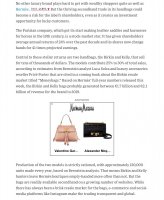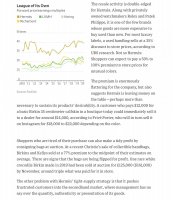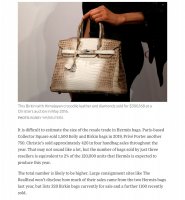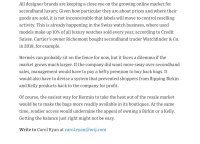You are using an out of date browser. It may not display this or other websites correctly.
You should upgrade or use an alternative browser.
You should upgrade or use an alternative browser.
Got a Birkin Bag to Sell? That’s a Problem for Hermès
- Thread starter jmc3007
- Start date
More options
Who Replied?Thanks so much for posting this. I was trying to read it earlier and couldn't access the article in its entirety.
Thank you for posting this. I believe the Birkin is the most written about handbag in history. IMO, each article is fascinating to read.
Interesting article. But H is a marketing genius that is why it is so successful. I know a lot of folks who buy from resellers or second-hand sources yet continue to try their luck in the H boutique itself. Why? Because H made it in such a way that being sold a highly coveted item in the “special room” and buying from the H store is a reward and an achievement by itself and gives an obviously happy feeling. In short, buying from the store is a very special experience by itself. That is why many clients keep on coming back despite of the fact that there are other avenues to source out an H item in a more simple way. How many brands have actually achieved that status? How many brands have actually been able to convince and train majority of their clients that being sold an expensive and “rare” item from them directly is a privilege? Genius indeed!
This article runs in line with a thought yesterday: When might Hermes do something similar to what Apple did a few years ago—start selling prior years models in competition with resellers?
Of course, Apple is still selling new makes of some former year’s models/products as well as refurbished units of certain others; and Hermes would theoretically be selling only top-quality refurbished pre-owned.
Apple’s move gutted my ability to resell “last year’s model” iPhone for enuf to buy “this year’s,” as I had joyfully done since 2009 to whenever they made the move. Apple captured the “profit” and My 2018 resale was maybe 50 percent what I needed to buy new iPhone. The only good news was I could trade in the old phone for 50 percent against the new one and not hassle with resale.
Food for thought.
I have trouble believing the B and K are “25 to 30% of total sales” for H.
Fascinating article, thank you for posting this!
I'm one of those people who has purchased two birkins on the resale market, yet is also building an in-store purchase history because I want the experience of getting a bag in-store, too. Pretty genius that it's not just about the bag, but the way in which you obtain it adds a specialness to the experience, too.
I was very intrigued to see how much higher the Hermes stock is than other luxury brands. Fascinating to see how much their mysterious marketing plays into their success.
Also, the article said that Rolex and Patek Phillippe watches cost more used, too. Why is that?
I'm one of those people who has purchased two birkins on the resale market, yet is also building an in-store purchase history because I want the experience of getting a bag in-store, too. Pretty genius that it's not just about the bag, but the way in which you obtain it adds a specialness to the experience, too.
I was very intrigued to see how much higher the Hermes stock is than other luxury brands. Fascinating to see how much their mysterious marketing plays into their success.
Also, the article said that Rolex and Patek Phillippe watches cost more used, too. Why is that?
Same reason as a Birkin. The more popular styles aren’t readily available to walk in customers. You either have to get on a waiting list or be familiar with the jeweler to have them think of you when a rare model comes in.Fascinating article, thank you for posting this!
I'm one of those people who has purchased two birkins on the resale market, yet is also building an in-store purchase history because I want the experience of getting a bag in-store, too. Pretty genius that it's not just about the bag, but the way in which you obtain it adds a specialness to the experience, too.
I was very intrigued to see how much higher the Hermes stock is than other luxury brands. Fascinating to see how much their mysterious marketing plays into their success.
Also, the article said that Rolex and Patek Phillippe watches cost more used, too. Why is that?
Why? Most times you have to spend approximately 1:1 to get a B/K so that accounts for 50-60% of revenue and then when you add in other expensive popular bags (Constance, Roulis, 24/24, evelyne, etc), plus the equestrian line, one time belt buyers, fashion jewelry and scarf lovers who don’t necessarily want a B/K right now...adds up to me.I have trouble believing the B and K are “25 to 30% of total sales” for H.
What I find most interesting is their estimate that 120,000 B/Ks are produced every year. With 310 Hermes stores worldwide, that’s under 400 bags per store per year or about one a day. I’m not sure how they got their estimates but it actually makes them seem even rarer to me.
Last edited:
Does anyone here read Business of Fashion? This analyst writes quite a lot there and his Hermes articles are often way off. I wouldn't take his and a reseller's estimates as necessarily close to reality. The H annual report tells you quite clearly what leather represents in revenue (50% in total approx and this includes SLGs and saddlery, where they still do quite well) - the 25-30% on just two bags styles seems like a guess to me.
I had no idea! Thanks for sharing.Same reason as a Birkin. The more popular styles aren’t readily available to walk in customers. You either have to get on a waiting list or be familiar with the jeweler to have them think of you when a rare model comes in.
Does anyone here read Business of Fashion? This analyst writes quite a lot there and his Hermes articles are often way off. I wouldn't take his and a reseller's estimates as necessarily close to reality. The H annual report tells you quite clearly what leather represents in revenue (50% in total approx and this includes SLGs and saddlery, where they still do quite well) - the 25-30% on just two bags styles seems like a guess to me.
I agree with you. BoF is not a credible source IMO, and I don't think this analyst is credible.
The Birkin and kelly contribute 25-30 % of total Hermès sales?
Is this Including the furniture, home decorating items, ready to wear, porcelain.
Is this Including the furniture, home decorating items, ready to wear, porcelain.
120,000 units of Birkin and Kellys per year seemed too high in my opinion.
Does anyone here read Business of Fashion? This analyst writes quite a lot there and his Hermes articles are often way off. I wouldn't take his and a reseller's estimates as necessarily close to reality. The H annual report tells you quite clearly what leather represents in revenue (50% in total approx and this includes SLGs and saddlery, where they still do quite well) - the 25-30% on just two bags styles seems like a guess to me.
I agree with you. BoF is not a credible source IMO, and I don't think this analyst is credible.
Another thing I want to note is that this "analyst" is not 100% transparent on their sources for these numbers and claims they are making, a big no no in proper journalism. I'm saying this because I studied quite a bit of journalism in school, now I'm no pro at it, but it is one of the basic fundamentals of journalism.
Register on TPF! This sidebar then disappears and there are less ads!




